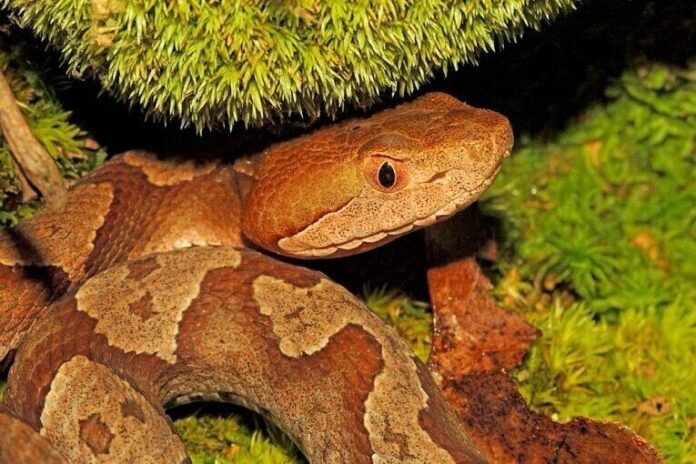
As the warm weather arrives, outdoor activities such as hiking, picnicking, and swimming become more popular in Tennessee. However, it’s important to note that the state is home to several species of snakes, which can pose a potential risk to humans and pets.
These snakes are not confined to wooded areas alone, as they can also be found in residential areas, including backyards. As such, it’s essential to know how to identify the dangerous ones for your own safety.
Fortunately, by far most snakes found in Tennessee are not venomous.
There are only four known species of venomous snake in Tennessee, and they all belong to the pit viper family.
1Copperheads

Tennessee is home to two subspecies of copperheads, the northern and southern. The northern is the most common species inhabiting most of the state. The southern is found primarily in the southwestern corner of the state. Copperheads generally reach between 24-36 inches. They have a base color of tan, peach or pink and have hourglass shaped saddles across the back. These chestnut colored saddles are widest on the sides and narrowest in middle of the back. The head often has a very coppery appearance giving these snakes their common name. They prey primarily upon mice but will also eat small, birds, lizards, small snakes and amphibians.
Copperheads are often found in old abandoned debris piles, rocky wooded slopes and abandoned pastures and fields where there is lots of cover. Generally shy and lethargic, they prefer retreat to encounters, but when disturbed they will often vibrate the tail, making a rattling noise when in old leaves. Copperheads are our least venomous snakes and deaths from them are extremely rare though they account for the most bites in Tennessee.
2Cottonmouth

The western cottonmouth is found west of the Tennessee River and in the counties of Cheatham, Dickson, Hickman, Humphreys, Perry, Wayne and Williamson. Cottonmouths are fairly large (30-42 inches), heavy bodied snakes. Found in aquatic habitats where they prey primarily upon fish and amphibians. (They can bite when under water.)
They are often dully colored, being almost black. While juveniles may be strongly patterned and brightly colored. Some adults may retain the pattern which appears as hollow, hourglass shaped bands across the back of the snake. Like the copperhead, the bands are widest on the sides and narrowest at the centerline of the back. When confronted, they often gape to display the cottony interior of the mouth and will often stand their ground. Note: All Tennessee snakes have a white mouth. When swimming their head is usually elevated above the water and their bodies appear overly buoyant, riding on the surface. However, they can submerge in search of fish and amphibians.
3Timber Rattlesnake

Timber rattlesnakes are found statewide mainly occupying heavily timbered second growth forests where rodents are abundant. They are very secretive and extremely shy avoiding contact with humans if at all possible. They are large, heavy bodied snakes commonly reaching between 36-60 inches in length. They usually have a base color of pale gray, tan or peach with dark cross-bands across the back. All black or almost all black individuals are not unknown.
4Pygmy Rattlesnake

The pygmy rattlesnake is found along the flood plain of the Tennessee River in Tennessee. It inhabits swamps, marshes, wet prairies and floodplains. They prey primarily upon frogs, salamanders, lizards and small mammals. It is rare throughout its habitat in Tennessee and is listed as Threatened by the Tennessee Wildlife Resources Agency. The pygmy rattlesnake gets its name from it’s diminutive size; rarely exceeding 20 inches in length. The rattle is extremely small and makes a sound more like the buzz of an insect than a rattlesnake.
Please Join Our FREE Newsletter!













